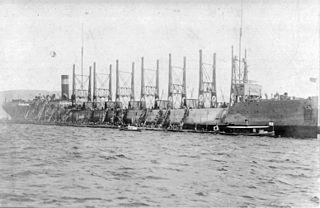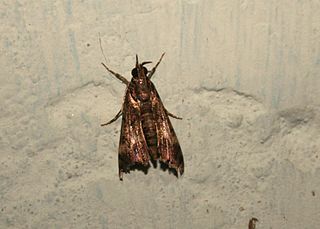
In Greek mythology, Nereus was the eldest son of Pontus and Gaia, with Pontus himself being a son of Gaia. Nereus and Doris became the parents of 50 daughters and a son (Nerites), with whom Nereus lived in the Aegean Sea.

4660 Nereus, provisional designation 1982 DB, is a small asteroid. It was discovered by Eleanor F. Helin on 28 February 1982, approximately a month after it passed 4.1 million km (11 LD) from Earth.

USS Nereus (AC-10) was one of four Proteus-class colliers built for the United States Navy before World War I. Named for Nereus, an aquatic deity from Greek mythology, she was the second U.S. Naval vessel to bear the name. Nereus was laid down on 4 December 1911, and launched on 26 April 1913 by the Newport News Shipbuilding and Dry Dock Company, Newport News, Virginia, and commissioned on 10 September 1913.
Agyrta is a Neotropical genus of moth in the subfamily Arctiinae.

Autochloris is a genus of moths in the subfamily Arctiinae.
Calonotos is a genus of moths in the subfamily Arctiinae. The genus was erected by Jacob Hübner in 1819.
Episcepsis is a genus of tiger moths in the family Erebidae. The genus was erected by Arthur Gardiner Butler in 1877.

Stomopteryx is a genus of moths in the family Gelechiidae.

Eurata is a genus of moths in the subfamily Arctiinae. The genus was erected by Gottlieb August Wilhelm Herrich-Schäffer in 1853.
Ichoria is a genus of moths in the subfamily Arctiinae. The genus was erected by Arthur Gardiner Butler in 1876.
Psilopleura is a genus of tiger moths in the family Erebidae. The genus was erected by Herbert Druce in 1898.
Ptychotricos is a genus of moths in the subfamily Arctiinae.

Saurita is a genus of moths in the subfamily Arctiinae. The genus was erected by Gottlieb August Wilhelm Herrich-Schäffer in 1855.

Udea is a genus of snout moths in the subfamily Spilomelinae of the family Crambidae. The genus was erected by Achille Guenée in 1845. The currently known 216 species are present on all continents except Antarctica. About 41 species are native to Hawaii.

Noorda is a genus of moths of the family Crambidae, and the only genus in the subfamily Noordinae.

Symmoca is a genus of moths in the family Autostichidae.
Episcepsis melanoneura is a moth of the family Erebidae. It was described by Hans Zerny in 1931. It is found in Brazil.
Episcepsis flavipuncta is a moth of the family Erebidae. It was described by Hans Zerny in 1931. It is found in Brazil.
Episcepsis rotundipennis is a moth of the family Erebidae. It was described by Hans Zerny in 1931. It is found in Bolivia.

HMS Nereus was a Admiralty M-class destroyer which served with the Royal Navy during the First World War. Launched in 1916, the vessel served with the Grand Fleet until the end of the conflict. The vessel operated as part for Thirteenth Destroyer Flotilla in support of convoy operations. In 1918, the flotilla took part in one of the last sorties of the war, although the British and German fleets did not meet and the destroyer returned without seeing any action. After the conflict, the destroyer was worn out by the demands of high speed operation in poor weather. Nereus was decommissioned and sold to be broken up in 1921 after less than six years service.










